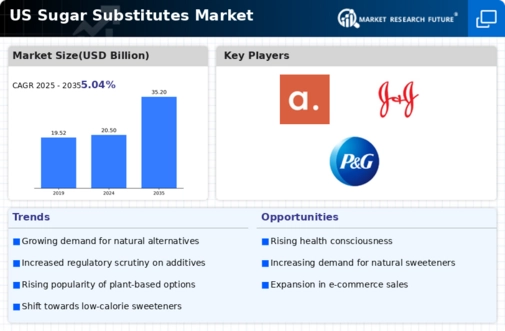Increasing Health Consciousness
The growing awareness of health issues related to sugar consumption is a primary driver in the sugar substitutes market. Consumers are increasingly seeking alternatives to traditional sugar due to its association with obesity, diabetes, and other health concerns. This shift in consumer behavior is reflected in market data, indicating that the demand for sugar substitutes has surged by approximately 20% over the past few years. As individuals prioritize healthier lifestyles, the sugar substitutes market industry is likely to expand further, with a focus on low-calorie and natural sweeteners. This trend is particularly pronounced among younger demographics, who are more inclined to experiment with various sugar alternatives. Consequently, manufacturers are responding by innovating and diversifying their product offerings to cater to this health-conscious consumer base.
Rising Popularity of Low-Calorie Diets
The increasing adoption of low-calorie diets is a significant driver for the sugar substitutes market. As more individuals aim to reduce caloric intake for weight management, the demand for low-calorie sweeteners has escalated. This trend is particularly evident in the beverage sector, where many brands are reformulating products to include sugar substitutes. Data suggests that the market for low-calorie sweeteners is projected to reach $3 billion by 2026, highlighting the lucrative opportunities within the sugar substitutes market industry. Additionally, the rise of diet trends such as keto and paleo has further propelled the use of sugar alternatives, as these diets often restrict sugar consumption. Consequently, manufacturers are increasingly focusing on developing products that align with these dietary preferences.
Consumer Preference for Clean Label Products
The trend towards clean label products is reshaping the sugar substitutes market. Consumers are becoming more discerning about ingredient transparency and are actively seeking products with minimal processing and recognizable ingredients. This shift is prompting manufacturers to reformulate their offerings, ensuring that sugar substitutes are derived from natural sources and free from artificial additives. The sugar substitutes market industry is adapting to this demand, with a notable increase in products labeled as organic or non-GMO. Market analysis indicates that clean label products are expected to account for over 30% of the total food and beverage market by 2027. This consumer preference is likely to drive innovation and create new opportunities for brands that prioritize transparency and quality in their sugar substitute offerings.
Regulatory Support for Healthier Food Options
Regulatory frameworks aimed at promoting healthier food choices are influencing the sugar substitutes market. Government initiatives encouraging the reduction of sugar consumption have led to increased support for sugar alternatives. Policies that incentivize the use of low-calorie sweeteners in food products are becoming more prevalent, thereby fostering growth in the sugar substitutes market industry. For instance, recent guidelines from health authorities advocate for lower sugar intake, which indirectly boosts the demand for sugar substitutes. This regulatory environment is likely to create a favorable landscape for manufacturers, as they can align their product development strategies with governmental health objectives. As a result, the sugar substitutes market may experience accelerated growth as more companies innovate to meet these regulatory standards.
Technological Advancements in Sweetener Production
Innovations in food technology are significantly influencing the sugar substitutes market. Advances in extraction and processing techniques have led to the development of new sweeteners that are both effective and appealing to consumers. For instance, the introduction of stevia and monk fruit extracts has provided natural alternatives that are perceived as healthier. The sugar substitutes market industry is witnessing a transformation as these technologies enhance the quality and taste of sugar alternatives. Market Research Future indicates that the segment for natural sweeteners is expected to grow at a CAGR of 15% over the next five years. This technological evolution not only improves product offerings but also supports the industry's efforts to meet consumer demands for transparency and quality in food products.














Leave a Comment